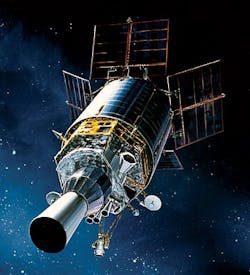Air Force researchers ask industry to develop new generation of space-based MWIR detector arrays
WRIGHT-PATTERSON AFB, Ohio, 11 March 2012. U.S. Air Force researchers are asking industry to develop and demonstrate large, low-noise, high-uniformity, medium-wave infrared (MWIR) detector arrays for the next generation of space-based launch detection aboard satellites similar to those that are part of the Defense Support Program (DSP) and Space-Based Infrared System (SBIRS) constellations of reconnaissance satellites.
The Air Force Research Laboratory at Wright-Patterson Air Force Base, Ohio, has released a broad agency announcement (BAA-12-05-PKM) for the High Resolution MWIR, Phase 1 Detectors program to advance space-based infrared detector materials growth and processing for medium-wavelength infrared sensor chip assemblies (SCAs) comparable in size to a 2,048-by-2,048-pixel detector in which each pixel measures 30 microns.
These new MWIR detectors would be the primary sensors aboard the next generation of reconnaissance satellites designed to detect the infrared emissions from intense sources of heat, such as missile launches and nuclear blasts.
Air Force researchers are asking industry to develop new MWIR detectors with a cutoff wavelength of 5 microns at an operating temperature goal of 130 Kelvin. The detectors must be in a p-on-n photovoltaic architecture, have thickness non-uniformity of less than 2 percent, and compositional non-uniformity of 1 percent.
The solicitation calls for epitaxial growth of detector films; detector processing; process assessment, characterization and screening techniques; hybridization and packaging; SCA radiometric testing and analysis; and program management and reporting. Radiometric testing will be necessary to characterize detector performance in quantum efficiency, noise equivalent irradiance, dark current, operability, and uniformity of response.
Air Force researchers expect to award two contracts for the three-year High Resolution MWIR, Phase 1 Detectors program -- one from Wright-Patterson Air Force Base, and the other from Kirtland Air Force Base, N.M.
Companies interested in submitting proposals should respond no later than 16 April 2012. Companies that intend to submit proposals should notify the Air Force's Bobbi Cunningham by e-mail at [email protected] no later than 30 March 2012. Submit proposals to Bobbi Cunningham by post at Building 167, 2310 8th St., Wright-Patterson AFB, OH 45433-7801.
For technical questions contact the Air Force's Joseph Burns by phone at 937-255-9594, by e-mail at [email protected], or by post at AFRL/RXPS, Building 651, Room 241, 3005 Hobson Way, Wright-Patterson AFB, OH 45433-7707.
For contracting questions contact Bobbi Cunningham by phone at 937-255-5476, by e-mail at [email protected], or by post at Det 1 AFRL/PKMM, 2310 8th Street, Area B, Building 167, Wright-Patterson AFB, OH 45433-7801.
More information on the High Resolution MWIR, Phase 1 Detectors program is online at https://www.fbo.gov/index?s=opportunity&mode=form&id=c636d0cc4141b3d7505ed4e9791754d0&tab=core&_cview=0.
